It took a while, but most Americans seem to have accepted four as a sufficient number of cylinders for their car's engine. Even many $50,000+ sedans are now sold with four-bangers. So auto makers have moved on to the next challenge: selling Americans on the viability of three-cylinder engines.
The only U.S.-market 2013 model with a three-cylinder engine was the barely-a-car Smart fortwo. Then, for 2014, three cars with back seats gained threes: the new, widely panned Mitsubishi Mirage (feeling no need to pile on, I haven't reviewed the car), redesigned Mini Hardtop, and refreshed Ford Fiesta. Of these, Ford has most actively promoted the advantages of its new, turbocharged three-cylinder engine (also available in the larger Focus this year). Is the EcoBoost 1.0 really good enough to not only take the place of the Fiesta's standard 1.6-liter four-cylinder engine, but command an option price of $995?
Looking beyond the engine, reviewers' favorite B-segment car, the Honda Fit, has been redesigned for 2015. Why might someone buy the updated, EcoBoosted Fiesta instead of the redesigned Fit?
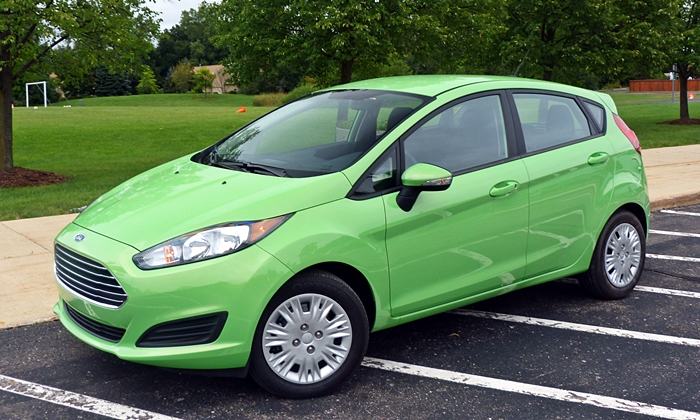
Attractive egg-shape undermined by the wheel covers that replace alloys with the EcoBoost engine. more Fiesta photos
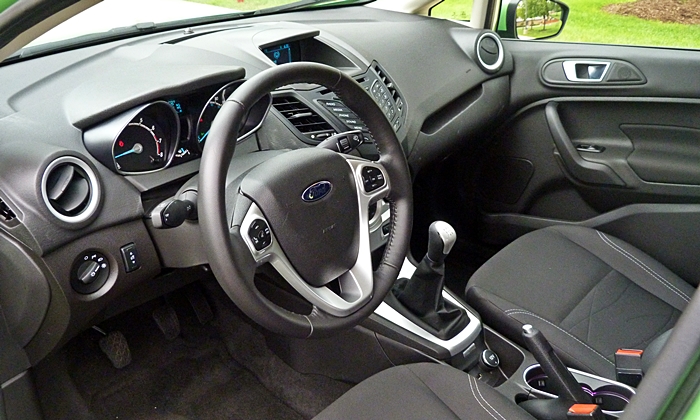
The Fiesta's interior looks and feels like that of other recent Fords. Very nice for the price.
| |
Compared to the Fit |
| Quietness |
 Better
Worse
Better
Worse
|
Before the Fiesta, the first and last car I had driven with a turbocharged three-cylinder engine was the 1987-88 Chevrolet Sprint Turbo. The Sprint's 1980s-tech engine was good for only 70 horsepower, but the car weighed a mere 1,600 pounds, so it felt quick. Problem was, the made-in-Japan-by-Suzuki hatchback also felt noisy, rough, and cheap. It was very much the sort of small car that made Americans feel the need for a much larger one.
Current small cars tend to be far smoother, quieter, and more solid than that Sprint. And the Fiesta is the smoothest, quietest, and most solid of the bunch. It sounds and feels like a premium car. The redesigned Fit remains considerably louder inside, if still quiet compared to that old Sprint.
And the EcoBoost triple? Three-cylinder engines are inherently unbalanced because, given their odd number, one cylinder cannot travel upward whenever another is traveling downward to largely cancel both movements out. To counteract the new engine's inherent vibration, Ford has unbalanced the flywheel and accessory pulley and has carefully tuned the engine mounts. These steps, while not entirely effective, reduce low-speed vibration to a level that shouldn't bother anyone interested in this class of car.
And the engine's sound? The three actually sounds better than most four-cylinder engines. Instead of the mild buzziness that emanates from under the hoods of the standard Fiesta and the Fit, the three voices an enticing growl. It sounds more like a six (half of one, anyway) than a four.
| Ride smoothness |
 Better
Worse
Better
Worse
|
Covered when discussing quietness, but worthy of separate mention: the Ford Fiesta rides unusually smoothly for a subcompact. The Fit doesn't ride harshly, but it feels less poised, solid, and upscale.
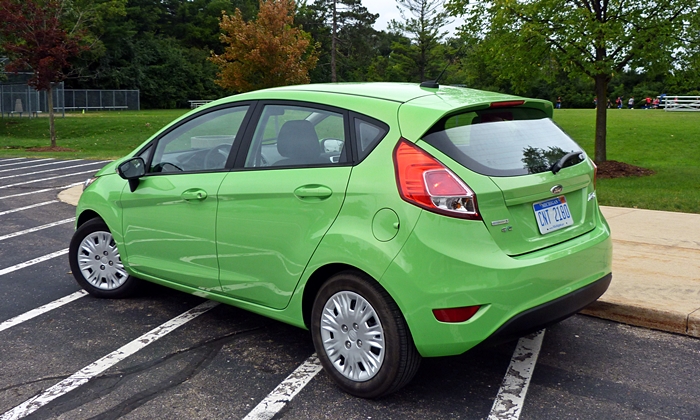
My favorite lines on the Fiesta are back here. Note how thoroughly the tail lamps are integrated.
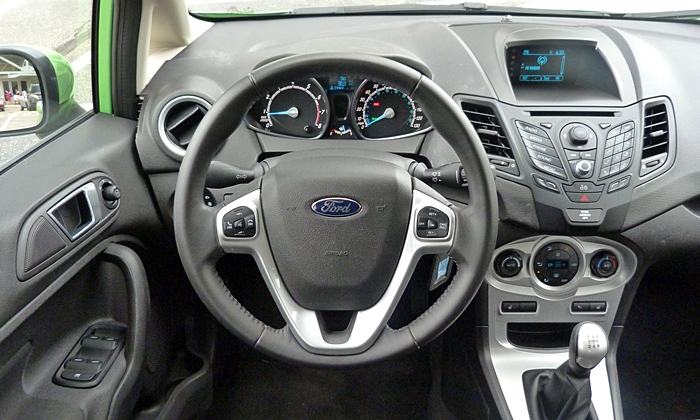
Odd controls. Perhaps they're more intuitive for European buyers?
| Materials & workmanship |
 Better
Worse
Better
Worse
|
Continuing in the same vein, the Ford Fiesta's interior materials look and feel European (no surprise, since the car was designed primarily for the European market). These materials are a cut or two above others in the segment, including the more plasticky (though not "cheap") Honda.
| Fuel economy |
 Better
Worse
Better
Worse
|
The ostensible point of a three-cylinder engine is superior fuel economy. Fewer cylinders generate less friction. On top of this, the Fiesta's new engine is smaller, just one liter compared to the regular Fiesta's 1.6 and the Fit's 1.5. It is turbocharged to compensate for this size difference. The payoff: EPA ratings compared to the regular Fiesta improve from 28 mpg city, 36 mpg highway to 31 and 43, respectively.
With a manual transmission, the Honda rates just a bit better than the regular Fiesta, and well short of the Fiesta EcoBoost on the highway: 29/37. But fit the Fit with a CVT (continously variable transmission), and its ratings roughly match those of the manual-only Fiesta EcoBoost: 33/41.
In real-world driving, the Fiesta EcoBoost's fuel economy varies widely depending on how much you exercise the turbo. The trip computer reported suburban averages as high as 51.7 mpg, and as low as 28.6. When I drove the car casually but without care to maximize fuel economy, the trip computer reported about 37 mpg. With some care, about 45. Very good, certainly, but some other small cars with less expensive, more conventional engines (such as the Nissan Versa Note, EPA 27/36 with a manual but 31/40 with a CVT) are about equally good.
| |
Compared to the Fit |
| Rear seat room & comfort |
 Better
Worse
Better
Worse
|
Just as the Ford Fiesta has some clear strengths, it also has some clear weaknesses. Its rear seat, though comfortably positioned well off the floor, is the tightest in the segment. At 5-9, I can barely squeeze behind myself. The Fit's rear seat is far roomier.
| Cargo capacity |
 Better
Worse
Better
Worse
|
The Ford Fiesta has even less room for cargo than for rear seat passengers. I managed to fit the family's weekly grocery run behind the rear seat, but with far less room to spare than in most hatchbacks. Fold the rear seat, and you'll find the resulting floor far from flat.
The Fit's cleverly engineered rear seat folds flat and low. So configured the Honda has over twice the cargo volume of the Ford, 52.7 vs. 25.4 cubic feet.
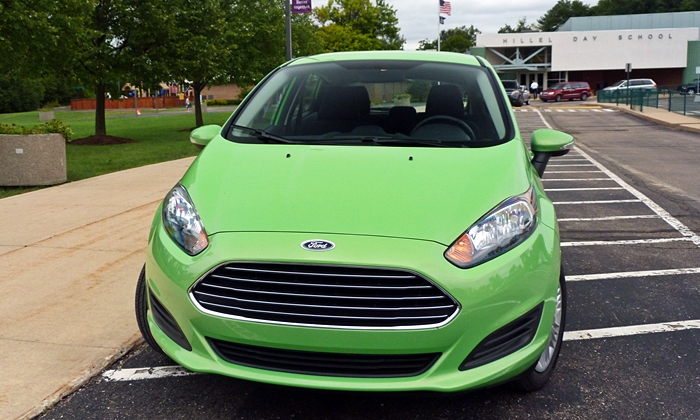
All Fiestas gained a new Fusion-like face for 2014.
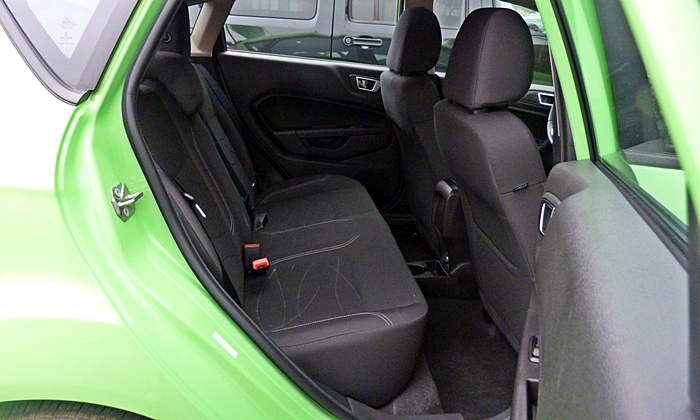
The Fiesta's rear seat cushion is comfortably high, but room is in short supply.
| Feature availability |
 Better
Worse
Better
Worse
|
Befitting the Fiesta's somewhat upscale character, you can get it with some somewhat upscale features, including leather upholstery, navigation, a rearview camera, a sunroof, and heated seats. But the leather, nav, and rearview camera aren't available with the EcoBoost engine. Nor are alloy wheels. Though these are standard on the SE trim level, the EcoBoost option package replaces them with steel wheels. Most limiting of all, the turbocharged three-cylinder engine is only offered with a manual transmission. While I personally prefer a manual, the great majority of car buyers require an automatic.
With the Fit, you can't get leather upholstery or a nav system with the manual transmission, but these are available with the CVT, which happens to be the most efficient powertrain in the car. So if you're looking for these amenities, a self-shifting transmission, and optimal fuel economy all in the same car, the Fit scores a clear win.
| Controls and instruments |
 Better
Worse
Better
Worse
|
You also can't get the MyFord Touch infotainment interface with the three-cylinder engine. This isn't entirely a bad thing. This interface remains difficult to operate, and is even more difficult in the Fiesta than in other Fords. Tthe touchscreen is both too small and too far away for easy finger tapping.
Then again, the standard infotainment controls--which are the only set available with the triple--include a baffling array of oddly arranged buttons. I've never come close to figuring them all out.
Honda's latest infotainment interface has its own issues. Most notably, it has no knobs, so adjustments must be made via with the steering-wheel-mounted controls or the touchscreen. But this touchscreen is at least closer and larger than the one you can only get without the EcoBoost engine in the Fiesta.
| Driving position & visibility |
 Better
Worse
Better
Worse
|
The view forward from the Fiesta's driver seat is an odd one. The windshield is narrow yet tall, and steeply raked. On sunny days it reflects the deep instrument panel. There's a bit of a fishbowl effect. The view rearward is compromised by smallish rear windows.
I never cared for the first and second generations of the Fit because the view forward from their driver seats seemed too much like that in a small minivan. With the third generation, though, Honda has lowered the driver seat and made it height adjustable (though only the shortest drivers are likely to take advantage of this addition). As a result, the view forward is now more car-like, even more than a little similar to that in the Fiesta, if still more open over an instrument panel that isn't quite as deep. Rearward visibility is also better in the Honda.
| |
Compared to the Fit |
| Exterior styling |
 Better
Worse
Better
Worse
|
I find the Fiesta's egg-shaped exterior attractive, with some especially artful lines in the rear quarters. The Fit, though improved, remains clunkier in appearance. But I'm not listing exterior styling among the reasons to buy the Fiesta SE EcoBoost because the engine package replaces the SE's standard alloy wheels with much less attractive hubcapped steelies. Why?
| Powertrain performance |
 Better
Worse
Better
Worse
|
The optional 1.0-liter EcoBoost three-cylinder engine doesn't produce significantly more peak power than the standard non-turbocharged 1.6-liter four: 123 vs. 120 horsepower. The Fit outpowers both, with 130. Then there are the transmissions. Both Ford engines are paired with a box that contains five tall, widely spaced ratios. Especially with the EcoBoost, a heavy flywheel (to counteract vibration) further blunts the engine's willingness to rev. Make it to the redline, and a shift then drops you well away from it. Honda pairs the Fit's peakier, more rev-happy engine with six more tightly spaced ratios. If you enjoy revving an engine to extract its potential, this is the way to go. And if you do extract its full potential, the Fit can get from zero to 60 mph in about 8.5 seconds, vs. about nine with either Ford engine.
The 1987-1988 Chevrolet Sprint Turbo, though down 53 horsepower, was nearly as quick as the Fiesta EcoBoost. How is this possible? Well, the Fiesta's larger car smoothness and quietness (and safety) bring with them larger car weight: about 2,500 pounds, vs. the Sprint's 1,600.
But foot-to-the-floor thrills aren't what the EcoBoost three is about. (For those, and even more when the road curves, get the 197-horsepower Fiesta ST.) Instead, the EcoBoost three-cylinder engine minimizes the need to rev. It has a stout midrange, as indicated by a peak torque of 148 lb-ft (very impressive for a 1.0-liter engine) at a low 1,400 rpm. The 1.6 manages only 112 lb-ft at a much loftier 5,000 rpm, the Honda's 1.5 114 lb-ft at 4,600 rpm. In typical around-town driving the turbo three feels considerably stronger than the non-turbo fours, with a smooth surge of satisfying torque the other engines simply can't deliver.
A caveat: despite the new three-cylinder engine's impressive torque spec, it lugs under 1,800 rpm. Given the widely spaced transmission ratios, it's quite easy to drop the engine below this floor when shifting. I learned to avoid shifting short of 2,500 rpm.
| Handling |
 Better
Worse
Better
Worse
|
The Fiesta's compliant suspension isn't without a cost. The steering and suspension feel a touch squishy, even mildly tippy, on center. Push through the initial squish, though, and both systems firm up nicely, delivering reassuring feedback and control. Hustle the Ford through some curves, and it feels good.
The Fit, with more steering assist, has a lighter but less planted feel. Compared to previous Fits, the suspension isn't quite as firm, to improve ride quality, and roll in turns has increased a little--but remains moderate. Picking the better handler between the two is more than a little a matter of taste. I personally prefer the Ford, but also felt confident when hurrying the Honda.
| Reliability & durability |
 Better
Worse
Better
Worse
|
The Honda Fit has long been among the most reliable cars in our survey. The Fiesta has a patchier record. This said, getting the manual in the Ford alt least avoids the problematic dual clutch transmission.
| Price or payments |
 Better
Worse
Better
Worse
|
The EcoBoost engine adds $995 to the base price of a 2015 Fiesta SE, bringing the total to $17,415. With this engine, options are limited to the attractively priced $290 Comfort Package (heated seats, heated mirrors, automatic temperature control) and a $795 sunroof. Oh, and some shades of paint cost extra. The "green envy metallic tri-coat" on the tested car lists for $595.
Factor in the alloy wheel deletion, and the EcoBoost engine actually costs about $1,350. Worth it? Unless you drive a lot of miles AND gas prices head upward again, probably not for reasons of fuel economy alone. But possibly for the combination of fuel economy and midrange torque. The Fiesta simply drives better with this engine.
A Honda Fit LX lists for about the same as the base Fiesta SE, $16,315. Factor in higher incentives on the Ford, and even with the EcoBoost engine it's likely to cost a little less than the Honda. And the Fiesta SE includes about $600 in additional features, including automatic headlights and leather-wrapped steering wheel. Bottom line: these cars are close enough in price that price isn't likely to be the deciding factor.
The Ford Fiesta SE EcoBoost is no Chevrolet Sprint Turbo. It's no tinny flyweight penalty box, and instead rides and drives with the solidity and polish of a larger, more expensive car. Its optional three-cylinder engine, rather than undermining these strengths as I had feared, actually enhances them. It makes the Fiesta an even more pleasant car to drive. Plus more fuel-efficient. Plus you can have some fun if you want to, though if you want a truly thrilling small car then the ST is the Fiesta to get.
On the other hand, the EcoBoost engine does nothing about the Ford's weaknesses. The Fiesta remains far tighter inside than the Fit. If space for people and cargo is a higher priority than smoothness and quietness, then the Honda is the one that impresses. If the past is any guide, the new Fit will also be extremely reliable, while the updated Fiesta could be somewhat problematic.
Either the Fiesta or the Fit is a great choice depending on your priorities. Know those, and you'll know which to buy.
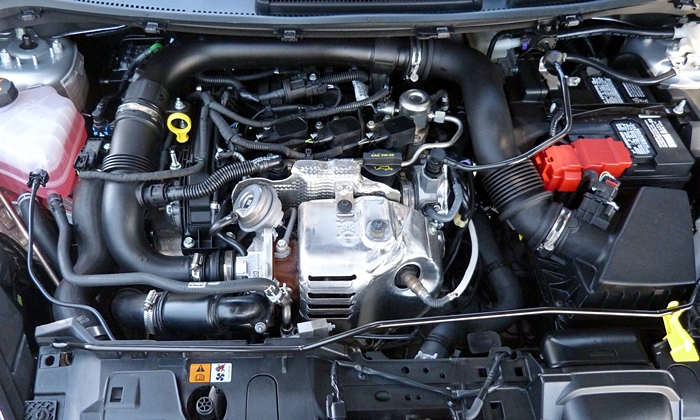
Unexpected: a three-cylinder engine that actually improves the driving experience as well as mpg.
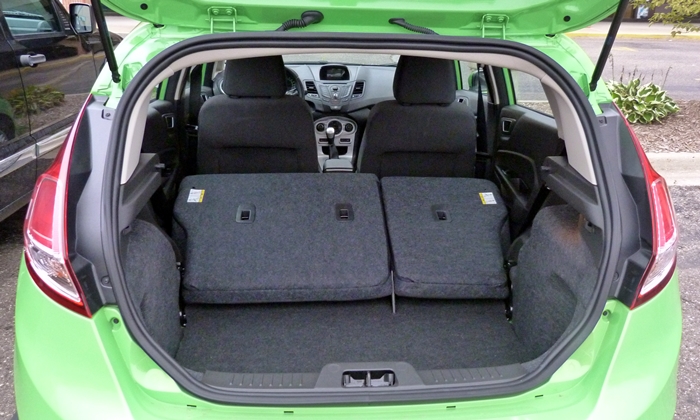
The Fiesta's load floor isn't remotely flat when its rear seats are folded.
See more 2014 Ford Fiesta photos
Ford provide an insured, fuel car for a week with a tank of fuel. I also previously drove both the Fiesta and the new 2015 Honda Fit at a regional media association event.











